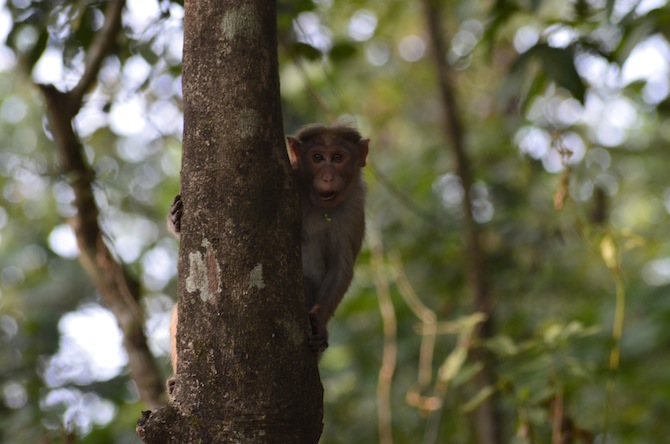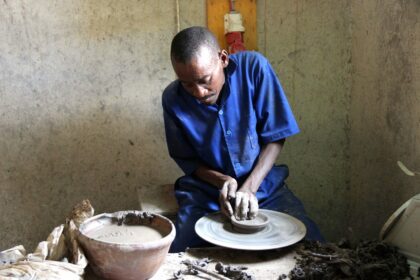After driving for eleven hours, mostly on unmade roads, we arrive at a game lodge about five hours drive from Nairobi. I am sitting in my luxury bedroom with electricity, trying to digest all the impressions of the last few days. Looking out of the window, I see an elephant walk past in the middle distance, but by the time I switch on my camera I have missed my chance and it has disappeared from view. Not an inaccurate example of the way in which I seem to live much of my life.
The abiding impression of this visit to the northern Kenyan pasturalist communities is that we have so much to learn from these low intensity food production systems, which are still operating on a vast scale. More than 3 million people from 26 tribes, constituting perhaps 10% of Kenya’s population, are nourished from these lands, which have very low rainfall and could not realistically support settled agriculture. Yet this is being achieved in a symbiotic partnership with the natural environment, without diminishing its wildlife or plant biodiversity. The impression is of an immensely complex whole, informed by the same organizing principle that we observe everywhere in nature.
The knowledge that holds it together and enables it to continue is held by the indigenous people and passed down from generation to generation, through oral transmission. Although it is obvious that these methods should be recorded and studied for their wider application, many of the skills could only be learned through practice and imitation. Roba told me that in his tribe, the boys start going out on their nomadic travels, which can extend to two months, as young as ten.
By contrast, my efforts to work toward system resilience over a mere forty years on our farm seem relatively crude. I do feel we are making progress, but it is the sheer subtlety and complexity of the skills and relationships that constitute these systems that blow me away. A critic might point out that the volume of food produced per acre would never feed nine billion, and of course that is true. But the repost would be to ask, can ‘modern’ agriculture get anywhere near this output with negligible use of non renewable external inputs including water and zero emissions, while at the same time maintaining the wildlife populations? I doubt it very much.

It has occurred to me that I’m actually staying at an example of the “alternative model,” a game park from which pasturalists have been excluded altogether in pursuit of income from tourism. I did ask what the typical difference in wildlife populations between this “park” and land occupied by indigenous people might be. This is not an easy question to answer, since it would depend on the grazing pressure from the number of domesticated animals they kept and whether or not they hunted. But perhaps the proof of the pudding was that on the way to Kalacha, when viewed only from the main road, we saw a veritable feast of wildlife, including ostrich, vultures, giraffe, monkeys, several species of antelope and hyena, all on land which was occupied by pasturalists.
We went out for two hours at 6:30 this morning in Toyota land cruisers with guides whose mission it was to show us wildlife. And we did see many species, including warthog and buffalo, but it wasn’t that spectacular a difference, and for my money, I would infinitely prefer chance encounters with wildlife on a lower volume, knowing that the indigenous people were able to live here, too.
From a wildlife perspective, this is the equivalent of the difference between catching fish on a stocked river compared to fishing wild. But it is so much more than that, because one has to add into the equation the extraordinary cultural diversity and beauty of the indigenous people. This links to a profound and perhaps unanswerable question, about the role of humanity in relation to our stewardship over nature. What I can say is that I have never in my life encountered people with who are so obviously living in harmony with nature, and it has been the most humbling experience. There is no doubt it has been a hugely significant experience for me, and so much more relevant to the issues that surround the challenges of developing truly sustainable food systems than I imagined it would be. I thought surely this example must have profound significance to the world at this time.

That Night…
We just had dinner in the restaurant, all one big opulent expanse, open plan with overhanging roof and no windows so you could see the safari park in the day, with one of those help-yourself buffets that comes with an accompanying risk of severe over indulgence. At the beginning of the meal, the waiter came up to us and asked with obvious pride if we would like to see the hyenas and the crocodile. Below the floodlit veranda, was a mangy hyena, looking rather unhealthy like scavengers so often do. But what really caught my eye was the fat crocodile, lying nearby. He appeared dangerously obese, if one can use that term for crocodiles, perhaps even on the edge of heart disease, which was hardly surprising, as the waiter told me he was feasting on all the left over meat scraps.
Opposite me at our table was Roba, slim, athletic and with all the grace of an antelope. Behind him was a large table, occupied by a prosperous Kenyan family, who had clearly escaped the ‘tyranny’ of self sufficiency in the bush by trading up to Nairobi city life, on holiday in the Safari Park enjoying the fruits of their new found wealth. But the shocking thing was the effect of the western lifestyle on their body mass index. They looked, without being rude, remarkably similar to so many overweight British families that one sees in motorway service stations, in other words well on the way to the state of the crocodile.
In that moment it was somehow all there to be seen, the consequences of our actions, the separation from nature, the safari park, urbanization, and the fat tourists coexisting with the mangy hyena, and the obese crocodile.
This post was written by Patrick Holden, Founder of the Sustainable Food Trust. It was originally published on the Sustainable Food Trust website.
Also Check Out:
Swimming Pigs In Azure Bahamian Waters [Photo]
A Look At The Mafia’s Control On The Italian Food System (And What’s Being Done About It)
Local Living On Italy’s Amalfi Coast
Jessica Festa
Latest posts by Jessica Festa (see all)
- A Culturally-Immersive Adventure In Mongolia’s Altai Mountains - Jul 8, 2023
- This Recipe Sharing Platform Supports Women In The Culinary Industry (Labneh Recipe Included!) - Nov 5, 2020
- Hiking The Mohare Danda Community Eco-Trek In Nepal - Jun 3, 2020
- 6 Important Questions For Choosing A Responsible Yoga Retreat - May 18, 2020
- How To Create & Grow A Profitable Blogging Business (Ethically) - Jan 18, 2020





